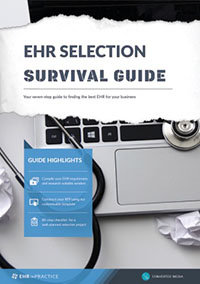5 key stakeholders in your EHR selection
When selecting an EHR system for your practice, it is important to have a clear strategy concerning what value the proposed EHR project will add to an organization’s healthcare mission. Developing a clear strategy depends on conducting a valid assessment of an organization’s challenges or opportunities for its healthcare technology. Key stakeholders are one of the best sources of information on which to base a technology strategy and, by association, EHR selection.
A key stakeholder is best described as an individual, or group of individuals, who possess valuable information regarding how an EHR performs, is able to provide valuable information regarding the financial or clinical performance of an EHR or generally any person or group whose performance within an organization would be affected by a decision related to an EHR such as whether or not to purchase or replace a system or the type of system deployed.
Based on the manner in which key stakeholders have a vested interest in both EHR-related decision making and the type of information they possess that can be used to optimize decision making, it reasons that key stakeholders should be consulted during the EHR selection process. With the importance of EHR stakeholders in mind, who should be consulted during the selection process?
1. Clinicians
Numerous studies examining EHR implementation outcomes point to the importance of obtaining input from clinicians during the planning and selection process. Due to their position on the front lines of providing clinical services these physicians, nurses, and allied health staff, are vital to a successful selection process by “providing input into the design, workflow sign-off process, and live support.”
It is important to allow several clinicians to test the system before purchasing and include at least one clinician representative on the selection team. Your clinician buy-in will increase exponentially if they feel that their needs are being met in your EHR selection.
2. Office manager/office staff
The front office staff and/or office manager are important stakeholders in the EHR selection process because they are responsible for inputting the demographic, billing and contact information of all the patients that will be coming through your practice.
It is important that office staff have a system that allows for easy and complete input of this important information. Further, this stakeholder group can offer vital information regarding challenges and opportunities particularly with regard to how an EHR or ancillary practice management software is either presenting challenges or may present opportunities for improvement with regard to such issues as channeling patients to providers and wait times.
3. Billing team/head of billing
The billing department is essential to your EHR selection process because, without the billing department, your practice will not get paid. The department will need a system that integrates well with existing billing systems or provides a new billing system in which claims can be processed efficiently and correctly. Stakeholders from the billing office will be best positioned to provide information regarding the speed and accuracy of processing claims and how an EHR, practice management system or billing system performs on these two metrics.
4. Board members/administration
Members of an organization’s C suite will occupy an important role either by furthering an EHR project, or acting as a barrier to its fulfillment. A great deal of attention has been paid to, particularly in larger organizations, the importance of obtaining buy-in from the C-Suite. Buy-in from this group is important given their role in management and finances, however, it is important to not focus too heavily on pitching a project to the C-suite and instead of soliciting input from this healthcare stakeholder group regarding opportunities and challenges to an organization’s EHR strategy.
Stakeholders in the C Suite can be pulled into the process of EHR selection to offer insight with regard to the financial side of the selection process, especially for specific functionalities or features that may result in cost reductions or added revenue. Involving the C Suite in this process from the start rather than pitching a technology plan toward the end of the selection process will encourage executive buy-in and also potentially provide a means to improve potential ROI in EHR technology. Given that recent survey evidence from healthcare executives taken at the 4th Healthcare Analytics Summit confirms that a majority (61%) of those executives surveyed viewed their ROI on EHR as terrible.
The administration and board members of the practice will be essential stakeholders because they will make important financial and operational decisions regarding the EHR project. Their input is important and highly valued. They should be shown that the new system will be an investment and that the cheapest EHR option is not always the best.
5. Marketing team
Although it may seem surprising, the marketing team can be greatly affected by an EHR selection. Some EHR systems have excellent features such as automatic scheduling, appointment reminders or online patient portals that improve patient/physician communication. These features are great marketing opportunities that your team should be aware of and promoting extensively.
These stakeholders add value to an EHR selection because the medical practice is comprised of so much more than just patient care. These individuals will help to create a thorough analysis of your practice needs. If you do not consult these team members, your EHR selection project will commence in the worst possible fashion.
In addition to increasing revenue, the marketing team can also play a role in gaining insight from a patient who may be engaging the EHR through a patient portal. Given the importance of patient engagement from both the perspective of Meaningful Use regulations, and value-based reimbursement, gaining insight for use regarding which features can best encourage engagement can pay dividends. Particularly given the link between patient engage, and increases in cost-efficient services and quality of care. For example, research shows that increases in patient engagement have been linked improved patient outcomes across a number of metrics, and have been shown to reduce the rate of preventable readmissions.
Stakeholders should be viewed as a vital component in the selection process not only as a source of information but also individuals and groups who can help guide the decision-making process. Given their importance, selection teams early on during the implementation planning process should survey their organization to determine who are the key stakeholders that should be included in the process.
Free white paper

How to sell your EHR project to senior management
Your comprehensive guide to securing funding and approval for your EHR project

Featured white papers
Related articles
-

5 important areas of EHR training during implementation
Successful EHR implementation is not possible without crucial EHR training
-

Top oncology EHRs to kickstart your selection shortlist
Learn about some of the leading oncology EHR systems on the market including CureMD, ARIA Oncolog...
-

How to pull together an EHR selection dream team
Top tips for choosing your EHR selection team, to ensure a successful selection process.




